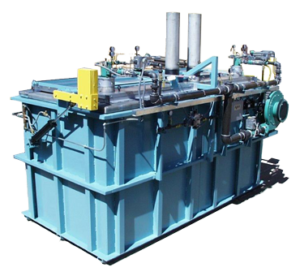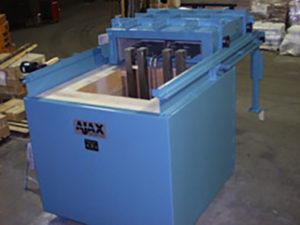Heat treatment is the heating and cooling of metal under tight regulations to improve its properties, performance, and durability. Essential to many industries, heat treatment serves as a core part of manufacturing.
Improving the raw state of metals, heat treatment makes them usable. Common applications include making metals softer to increase their formability or making them harder to improve their durability. This method also works to blend different types of metals.
 Heat treating plays an important role in many industrial sectors, and many of them would fail without this necessary salt bath treatment, or a similar furnace solution such as ceramic pot furnaces and isothermal quench furnaces. Manufacturing industries require this process to reduce stress on metal parts necessary for their day-to-day functions.
Heat treating plays an important role in many industrial sectors, and many of them would fail without this necessary salt bath treatment, or a similar furnace solution such as ceramic pot furnaces and isothermal quench furnaces. Manufacturing industries require this process to reduce stress on metal parts necessary for their day-to-day functions.
Heat treating is applicable in a wide range of industries, including the following:
- Aerospace. Without solution heat treatment of aluminum, parts like those used for airplanes become more vulnerable to fatigue. In the aerospace industry, these parts must fulfill the extreme demands put on metal parts like airplane engine components, helicopter frame parts, and more.
- Heavy machinery. In the production of heavy machinery, heat treatment is commonly applied to metals like iron and steel, but also on alloys of magnesium, nickel, titanium, copper, and aluminum. It ensures strong, durable equipment for construction and other industries.
- Automotive. Critical to creating necessary metal parts such as fasteners, gears, axles, crankshafts, and camshafts, the automotive industry depends on heat treatment services in their production.
The following provides an overview of the various forms of heat-treating applications.
Annealing
Annealing heat treatments involve heating steel (and other metals) to extremely high temperatures and then cooling it slowly until it reaches room temperature. The gradual cooling process can take minutes, hours, and even days, depending on the type of metal and desired outcome. Typically rod and wire materials are annealed in salt.
The process of annealing takes place in three stages:
- Recovery. A recovery stage includes heating the metal to the required temperatures. Ideally, this stage will continue until the steel’s internal stresses are eliminated.
- Recrystallization Temperature. During the recrystallization stage, the metal withstands heat to a temperature just above its recrystallization temperature level. The result is the formation of new grain without prior stresses.
- Grain Growth. In this stage, the new grains formed during recrystallization fully develop, thanks to a gradual cooling period.
Annealing provides many benefits, including improving the formability and conditioning the metal so as to change its machinability. Without this annealing, brittle metals can wear down and affect a machine’s ability to operate.
With reduced stress, annealing also encourages these effects on metals:
- Increased ductility and agility
- Improved magnetic properties, material structure, and toughness
- Reduced hardness and brittleness
Learn more about annealing to see if its the solution for your next project.
Neutral Hardening & Solution Hardening of HSS Parts
A process of hardening helps to strengthen a metal’s structure. The process demands heating a metal part to a set temperature necessary for the metal’s transformation and then cooling it quickly. Heating continues until the pearlite transforms into austenite. The rapid cooling process ensures that even the soft inner metal hardens. Furnaces operating this application typically operate over a 1400°F – 2350°F range.
 Hardening a metal yields many advantages, including:
Hardening a metal yields many advantages, including:
- Increased durability. Materials which have undergone the process of hardening have a more stable structure due to this transformational process. This stronger structure can withstand more than it could prior to the hardening process.
- Improved heat resistance. Through the specific process of induction hardening, surface hardness of a metal is increased while a core remains unaffected. After hardening, this altered metal has the ability to withstand higher temperatures than with its original surface structure before transformation.
- Improved mechanical utility. Because of the tougher structure gained after hardening, a metal develops strength necessary to change the brittleness of a metal. This toughness, achieved through metal quenching, improves mechanical properties.
Austempering and Martempering
Austempering is applied to medium-to-high carbon-ferrous metals. This process increases the metal’s formidability and toughness while also reducing distortion.
Austempering breaks down into a four-stage process. To begin, a metal is heated to temperatures between 1,500°F and 1,650°F, depending on the material. Then, the metal is quenched in a bath of molten salt maintained at a constant temperature of between 550°F and 650°F. Until a metal part is austenitized, carbon atoms cannot dissolve into that part to add hardness or transform the structure. Held in this state for some time, the metal develops a bainite microstructure. Finally, the metal is cooled to room temperature.
Providing benefits beyond increasing toughness, strength, and hardness, Austempering can develop the ability for part of a metal to resist hydrogen embrittlement. When a metal experiences hydrogen embrittlement, the structure succumbs to stress fractures less than the metal’s usual yield strength. Beyond that, Austempering can benefit a metal in the following ways:
- Increased ductility
- Reduced distortion
- Improved resistance to shock
In martempering, the work is held at, or somewhat above, the temperature at which martensite begins to form, long enough to equalize temperature throughout the piece, but not long enough to permit transformation into bainite. The work is then air-cooled to room temperature. Martensite is the result, and due to its formation under low thermal and transformational stress due to the small temperature differential between the surface and center of the work, it is possible to secure maximum hardness with exceptional strength and toughness.
Some main differences between Austempering and Martempering:
- Martempering is when a work piece is heated to a certain temperature, then quenched before full transformation, in Austempering a workpiece achieves a certain temperature, and stays there until complete transformation, then is quenched as well.
- Martempering achieves high toughness and hardness on heavy sections of metals in the range of RC 60 and above. Austempering achieves toughness and hardness between RC35 and RC45 on light sections of metals.
Dip Brazing
A sophisticated method, dip brazing describes a process for joining two pieces of metal. When the assembly is immersed in the molten brazing salt, the alloy is held in place by the set flux acting as a cement while it is being heated and melted. The flux has a higher melting point than either the brazing alloy or the brazing salt, but it is soluble in the salt bath. Thus, the brazing alloy is held in place, even while melting, until the flux has been dissolved by the molten salt. As the flux is dissolved away from the molten filler metal, the alloy runs into the joint spaces and bonds the two pieces.
Some examples of different materials that get brazed and at what temperature:
- Brazing aluminum alloy at temp. 1080°F – 1120°F
- Brazing of ferrous and non-ferrous assemblies with silver brazing filter metals within temperatures of 1250°F – 1850°F
- Brazing of ferrous assemblies with brass, bronze, or nickle-silver alloys at 1675°F – 1750°F
- Brazing of ferrous assemblies with copper at 2050°F
Though a complicated process, dip brazing produces strong bonds between metals. This method also:
- Works with precision parts
- Solves complex joining designs
- Blends metals and non-metals
- Can braze many joints at same time
- Partial brazing of a piece so a different braze can be applied later
Metal Stress Relieving
To eliminate or minimize residual stress in a metal, metal stress relieving can be performed. It reduces weaknesses that may make the metal change dimensions during application.
Metal stress relieving involves the processes of heating and cooling. To start, a metal is heated to its specific set temperature. Depending on the type alloy, this metal stays soaking in this heated state for one to two hours. After soaking, the metal cools gradually in a furnace or airs out in the open. This slow cooling method serves a critical purpose in preventing tensions that arise when differences in temperature within the metal occur.
Metal stress relieving can yield the following benefits:
- Upholds dimension on precision parts
- Minimizes stress after machining
- Relieving tension in wielded structures
Descaling
A descaling salt bath removes scale from stainless plate and sheet without attacking the base metals. These furnaces typically operate at temperatures around 700°F.
Any item item that has water running through builds up mineral deposits, or scale, which can be difficult to remove. In large scale production parts can be de-scaled and used again without affecting the structure of the piece.
Some more applications of descaling with a Salt Bath furnace:
- Large scale stripping paint off parts
- Cleaning Process molds
- Descaling of nooks and crannies impossible to reach by other means
Additional Heat Treating Applications
Heat treatment is a vast practice with a wide range of other services. While it often can be applied to metals, other types of materials benefit from heat treatment. This practice can include, but is not limited to essential tasks, such as:
- Cleaning of molds
- Plastics and Glass removal (stripping)
- Glass – chemical strengthening by ion-exchange
- Heat generation, storage & transfer – for high temperature stored energy applications
- Plastic and rubber curing
- Shape setting of TiNi shape memory alloys
- Solution treatment of aluminum alloys
- Surface preparation of carbide tips for brazing
- Tempering
- Thermal diffusion of carbide-forming elements
Ajax Electric – Fast, Efficient & Reliable Heat Treating Equipment
Ajax continues to lead the heat-treating solutions industry in the U.S. and beyond. With 60 years of experience serving domestic and international customers, Ajax has refined and perfected its practices in creating heat treatment products capable of assisting numerous industries and applications. Using the latest in industry technology in building our furnaces, such as salt bath furnaces, Ajax provides efficiency, versatility, and cost-friendliness for these essential services.
Looking for a heat treatment? Don’t settle for less! Contact Ajax and find the right solution for your heat treatment needs.

